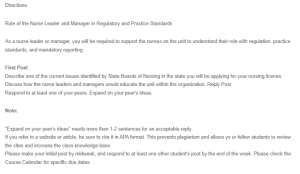Role of the Nurse Leader and Manager in Regulatory and Practice Standards – Lack of Motivation
One of the current issues noted in Minnesota involves the lack of motivation among nurses. This issue may lead to poor health outcomes associated with altered quality of care delivered by demotivated nurses. Substandard care is mostly related to poor health outcomes. Various ways can be used to motivate nurses and boost their zeal to work and deliver quality care to the patient and achieve desirable health outcomes that meet patient needs and expectations. These include timely remunerations per the agreement during hiring, a good working environment, maintenance of nurse’s welfare, and proper conflict resolution strategies. Overlooking these strategies may cause nurses to be demotivated, negatively influencing the overall health of the entire population. However, nurse leaders might mitigate this non-conformity through various ways enshrined in their roles and responsibilities, such as increased support supervision, facilitating continuous education, ensuring appropriate ratios during staffing and resource allocation, and steering other motivation activities (Gupta et al., 2021).
Nurse leaders and managers can educate members within their organizations through various approaches to improve the overall quality of care delivered and increase the level of motivation of their staff members. For instance, nurse managers can organize and facilitate continuous medical education and training programs to equip their members with the latest health trends. Secondly, nurse managers can research and implement the best leadership strategies during their managerial jurisdiction, such as appropriate supervision that educates their team members, disciplinary processes, and conflict resolution. Also, nurse leaders can set role models for the best nursing practices, which would educate their team members by emulating them. Lastly, according to Brunt and Bogdan (2023), nurse managers could participate in policy development committees and give insight into the best policies to implement to achieve the best nursing outcomes by allowing nurses education.
References
Brunt, B. A., & Bogdan, B. A. (2023). Nursing professional development leadership. National Library of Medicine; StatPearls Publishing. https://www.ncbi.nlm.nih.gov/books/NBK519064/
Gupta, J., Patwa, M. C., Khuu, A., & Creanga, A. A. (2021). Approaches to motivate physicians and nurses in low- and middle-income countries: A systematic literature review. Human Resources for Health, 19(1). https://doi.org/10.1186/s12960-020-00522-7
ORDER A PLAGIARISM-FREE PAPER HERE
We’ll write everything from scratch
Question
Directions:
Role of the Nurse Leader and Manager in Regulatory and Practice Standards

Role of the Nurse Leader and Manager in Regulatory and Practice Standards
As a nurse leader or manager, you will be required to support the nurses on the unit to understand their role with regulation, practice standards, and mandatory reporting.
First Post
Describe one of the current issues identified by State Boards of Nursing in the state you will be applying for your nursing license. Discuss how the nurse leaders and managers would educate the unit within the organization. Reply Post
Respond to at least one of your peers. Expand on your peer’s ideas.
Note:
“Expand on your peer’s ideas” needs more than 1-2 sentences for an acceptable reply.
If you refer to a website or article, be sure to cite it in APA format. This prevents plagiarism and allows yo ur fellow students to review the cites and increase the class knowledge base.
Please make your initial post by midweek, and respond to at least one other student’s post by the end of the week. Please check the Course Calendar for specific due dates.

